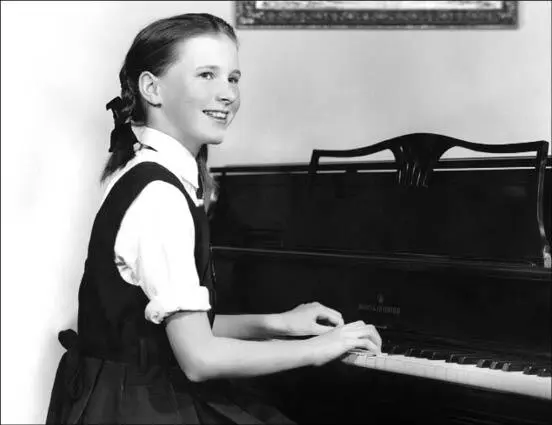I loved going to school and I enjoyed all the rituals of the Catholic upbringing: the lily parades, the first communion, the incense, retreats, candles, ribbons, and medals. Confession every week did strike me as a little ludicrous and, already a performer, I worried that the priest would get bored with the tiny scope of my sins and found myself spending a great deal of energy and imagination dreaming up more exotic ones to keep him entertained; I believe he was quite amused. Unlike most of the other little girls, I never felt any desire to become a nun, probably because already, at the age of five or six, the concepts of freedom of thought and individualism had taken hold in my young mind. Also, I was already ambitious, and the thought of wearing black robes every day seemed rather dreary; the life of the Cloister and of obedience didn’t strike me as much fun or worthy of aspiration.
The education at the Convent in the 1950s was based heavily on learning pages and pages of grammar, Catechism and history by heart. Luckily for the nuns, early Canadian history is full of the exploits of Jesuit and other Catholic missionaries (not to mention nuns), so they had a field day, and it was all very exciting for a young mind – to ghoulishly revel in the horrific stories of Fathers’ Brébeuf, Jogues and Co.’s martyrdoms at the hands of my aboriginal ancestors. I also believe that this early memorising provided excellent training for when I later started to develop my repertoire at the piano. To this day I memorise new pieces extremely quickly, and I attribute this small but useful talent to the style of education I received at the Sacred Heart Convent.
Many of the nuns were from poor Irish backgrounds or French-Canadian country families, and their characters ranged from boorish to mostly very pleasant and kind. But occasionally one struck gold, as I did in my third and fourth year, when I was taught by a remarkable woman, the younger daughter of a distinguished Montreal family – the Duchastels – who were friends of my grandparents. Quite elderly at that time, she was highly civilised, well educated, had a wicked sense of humour and was a totally delightful person. I loved her dearly and believe the feeling was reciprocated. I flourished under her guidance, loving school and eagerly absorbing any bit of knowledge she would impart. However, she never seemed to award me any of the ribbons or medals so beloved in Convent life and that she would lavish on the other little girls. In frustration, I once asked her why I was always overlooked, citing my good marks and general good behaviour; Mother Duchastel just nodded wisely and, smiling, pointed out that I didn’t need any extra encouragement and that I was already far too pleased with myself!
In 1960, when I was nine, my world changed drastically and irrevocably. That summer we travelled to France, ostensibly for a family holiday. However, Biddy had ulterior motives, a vision of my possible musical career having taken hold in her mind. At the time I never questioned my mother’s actions or motives. One didn’t in those days. Besides, I was a self-satisfied little creature with plenty of ambition and a major desire to impress my parents. It was still all a big lark to me.
I had learned a short program to play for her pre-war piano teacher, Mademoiselle Anne-Marie Mangeot in Paris. The program (unimpressive by the standards of today’s mini-monsters, who play Rachmaninov’s 3rd piano concerto at the drop of a hat, shortly after leaving the cradle) consisted of a Bach two-part invention, a movement from a Mozart Sonata, Debussy’s “Golliwog’s Cake Walk,” and a Cramer Etude. After hearing me play, Mlle. Mangeot suggested to Biddy that perhaps now was the time for me to start up serious music studies at a conservatory or music school. This gave Biddy the green light to intensify and lengthen my practice sessions with her and the search was on to find me a teacher.
It was my great good fortune to be living in Montreal at a time when arguably the greatest piano pedagogue in Canadian history was teaching at a local music school. The school itself was impressive enough. Newly finished, it was the brainchild of an extraordinary nun, Soeur Marie-Stéphane. She had been in Paris as a young nun and had met the rather obscure French composer, Vincent d’Indy, who was renowned in Paris for having created his own unique music school, the Schola Cantorum. Armed with ideas, inspiration and a divine mission to succeed, iron-willed little Soeur Marie-Stéphane came back to Canada, started lobbying and by the time I appeared on the scene, in the fall of 1960, the impressive École Vincent d’Indy was practically completed; an imposing structure built on the side of Mont Royal overlooking the predominantly French Canadian sector of Montreal known as Outremont; it had a state-of-the-art recital hall, facilities for boarders, many practise rooms and pianos, a cloistered area for the nuns’ living quarters, a lovely chapel, library, kitchen, and studios and reception rooms. The quality of teaching was first-rate. My aunt Rosanna, who had never heard of Vincent d’Indy but was Quebecker enough to know that 90 per cent of the place names in Quebec are those of obscure saints, would innocently refer to the school as Saint Vincent des Indes, and so the name stuck in our family; it was affectionately and more commonly referred to, by irreverent students, as V.D.

When I arrived there with Biddy one early September day for my first lesson, we were met at the entrance by a beautiful young nun named Soeur Stella Plante. The daughter of a doctor in far away Thetford Mines, Quebec, she had originally wanted to be a nurse and had been promised by the Order that if she “joined up” at the tender age of seventeen, they would train her so that she could pursue her dream. She did take her vows, but the higher-echelon nuns had other plans for her. So obvious was her unusual talent for music that it was no surprise she ended up teaching piano at their best music school and the nursing was put on hold. She became my teacher for the next seven years – two lessons a week. She was enthusiastic, ambitious and had an incredible spark for igniting students’ interests and inspiring them to strive for perfection. I loved my lessons and was also, for a while, happy to practise for hours every day, as it was all very exciting and new. Biddy was happy as well; the teaching was sound and followed along the lines of the French schooling she herself had received in Paris: a great deal of Solfège and Dictation, Theory and History, Counterpoint and Gregorian Chant. The repertoire I learned consisted mainly of Bach, the classics and French music.
During the fall of 1960, there was another change. Biddy took me out of the French- speaking Sacred Heart convent and put me into the English Protestant school known as The Study, where they generously worked their entire schedule around mine so that I could have ample time to practise the piano every day.
By the age of ten, I had progressed enough to be playing the first movement of Mozart’s Piano Concerto K. 466 with the Montreal Symphony, the venerable Wilfrid Pelletier conducting. To play with an orchestra for the first time was breathtaking. I was overwhelmed by the different sounds and orchestral textures all blending in so magically with what I was playing. I felt this amazing burst of warmth radiate through my body, and my inner eye was blinded by a kaleidoscope of fantastic colours.
By the age of eleven, although still going to The Study full-time, I was also practising at least five hours a day. I seemed to manage fine, juggling everything without fuss, although, other than seeing my classmates at school, there was never time for socialising during the off-school hours. If it hadn’t been for Peter, I might have turned into a far greater social recluse than I actually became.
Читать дальше













